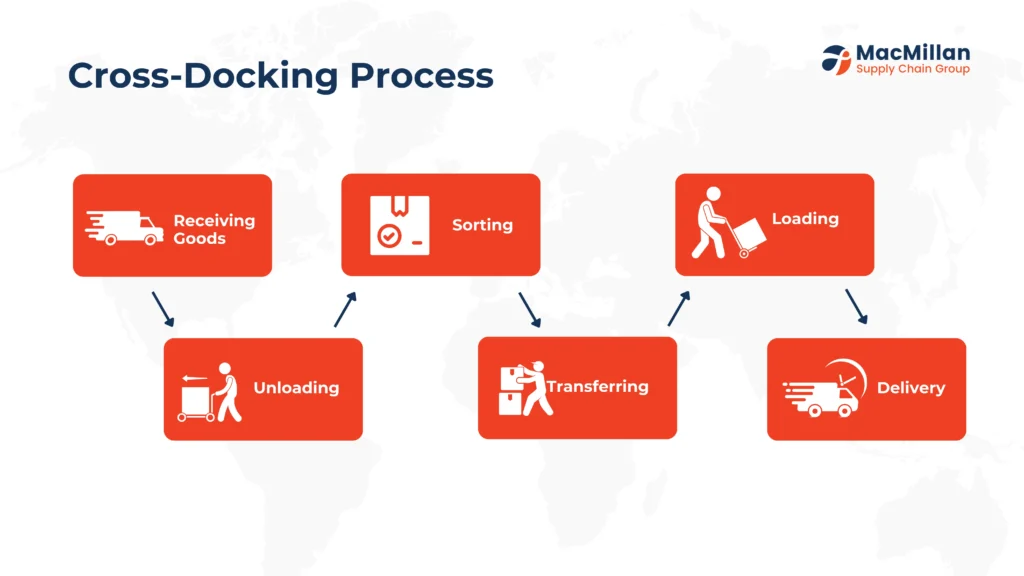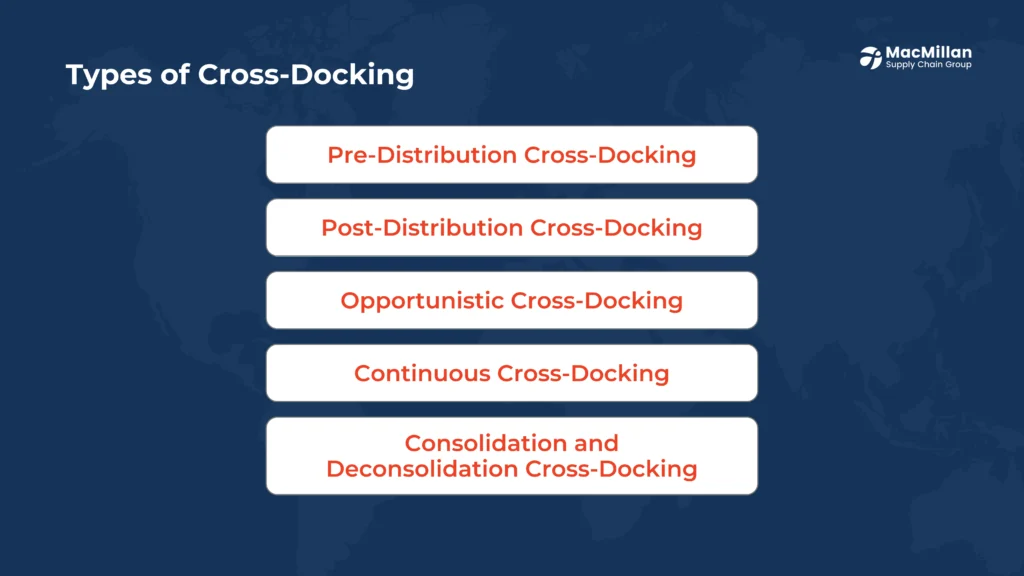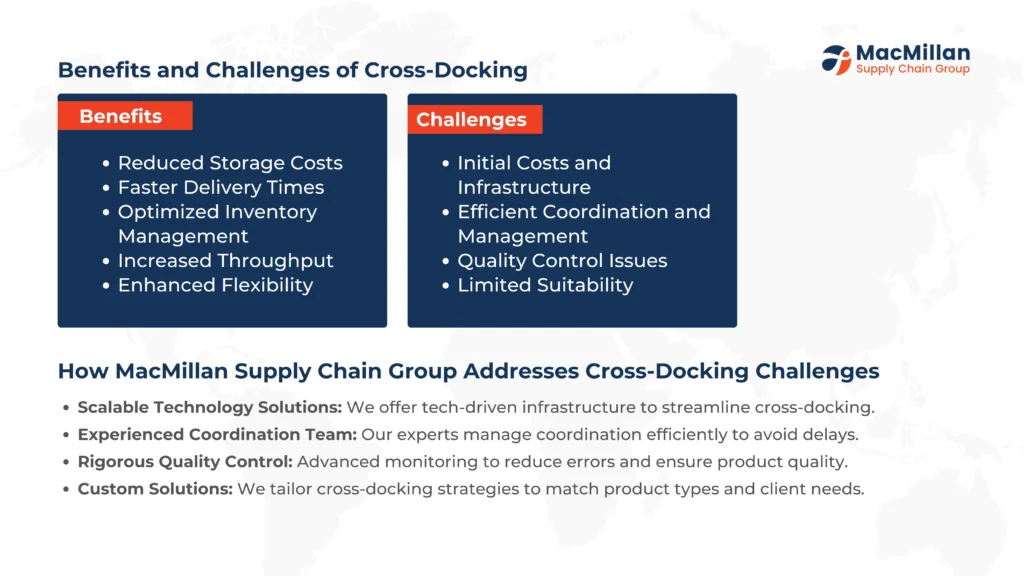A quick summary and overview
Cross-docking is a revolutionary logistics strategy that bypasses traditional warehousing by transferring goods directly from inbound to outbound transport with minimal storage. This technique optimizes supply chain efficiency, reduces costs, and accelerates delivery. Beneficial for industries like retail, manufacturing, and eCommerce, cross-docking meets the growing demand for quicker, seamless fulfillment processes. With MacMillan Supply Chain, businesses can leverage expert solutions to enhance logistics operations—ushering a new era of streamlined supply chain management.

An introduction
In a fast-paced market where timely delivery is paramount, cross-docking emerges as a pivotal logistics strategy. This innovative approach transcends conventional warehousing methods by expediting the movement of goods from receiving to shipping with negligible storage time. Not only does this technique significantly reduce storage costs and handling time, but it also caters to the escalating need for enhanced customer satisfaction through quick and efficient delivery. At MacMillan Supply Chain, we understand the intricacies and potential of cross-docking to transform your logistics operations, helping you stay ahead in a highly competitive industry. Explore the types, processes, and benefits of cross-docking and see how optimizing these can support your operational goals and foster sustained business growth.
Understanding Cross-Docking
Cross-docking involves moving goods from inbound to outbound docks with no or minimal intermediate storage, a practice known as ‘just-in-time’ shipping. This logistics strategy streamlines operations by eliminating the need for warehousing, thus reducing associated costs. Predominantly utilized in eCommerce, retail distribution, and manufacturing warehouses, cross-docking is effective in managing backorders and improving delivery times. It enables products to reach end-users faster by seamlessly bypassing complex inventory processes typical of traditional warehousing.
MacMillan Supply Chain leverages state-of-the-art warehouse management systems to implement cross-docking solutions that are customized to meet your business needs. These systems ensure real-time tracking of goods, enhance inventory management, and facilitate efficient labeling and sorting processes, further driving operational efficiency. By strategically utilizing cross-docking, businesses can not only optimize their supply chains but also improve delivery metrics and customer satisfaction.

Types of Cross-Docking
Understanding the various cross-docking methods can help businesses choose the most suitable strategy for their needs. The primary types include:
- Pre-Distribution Cross-Docking: Goods are received, sorted, and sent directly to customers without warehousing, ensuring immediate dispatch and efficient order fulfillment.
- Post-Distribution Cross-Docking: Goods are temporarily stored at a terminal for sorting and consolidation before final delivery, allowing for better order customization.
- Opportunistic Cross-Docking: This method is used on an as-needed basis to quickly respond to unexpected demands or fill urgent orders by using existing inventory efficiently.
- Continuous Cross-Docking: Involves non-stop movement of goods through the distribution pipeline, focusing on reducing delivery lead times.
- Consolidation and Deconsolidation Cross-Docking: This involves combining or breaking shipments to minimize transportation costs and improve delivery timelines.
MacMillan Supply Chain helps businesses implement the most suitable cross-docking method tailored to their operational needs, ensuring optimized processes and substantial cost savings.
Benefits of Cross-Docking in Logistics
Cross-docking provides several key benefits that contribute to enhanced supply chain efficiency:
- Reduced Storage Costs: By eliminating the need for warehousing, cross-docking significantly cuts down storage-related expenses. This leads to reduced overheads and boosts operational profitability.
- Faster Delivery Times: Goods move through the supply chain more swiftly, improving lead times and enhancing customer satisfaction with quicker deliveries.
- Optimized Inventory Management: Cross-docking helps maintain lean inventory levels, reducing waste and ensuring that products are always fresh and available for dispatch.
- Increased Throughput: By minimizing handling and storage, facilities can handle larger volumes of goods more efficiently.
- Enhanced Flexibility: Businesses can quickly adapt to changing market demands, ensuring they can meet customer expectations swiftly.
MacMillan Supply Chain’s expert cross-docking solutions allow businesses to capitalize on these benefits, providing them with a competitive edge in logistics management.

Implementing Cross-Docking: Challenges and Solutions
While cross-docking offers numerous advantages, its successful implementation can pose certain challenges. Recognizing these common problems is the first step towards overcoming them:
- Initial Costs and Infrastructure: Setting up a cross-docking facility demands significant initial investment for infrastructure and advanced technology, such as automated warehouse management systems. Businesses might find it challenging to allocate initial funding.
- Efficient Coordination and Management: Cross-docking requires meticulous coordination between suppliers, transporters, and distribution centers. A lack of synchronization among these components can lead to inefficiencies and shipment delays.
- Quality Control Issues: The rapid handling of goods might increase the chances of shipping errors, damaged products, or misplaced shipments, which can affect customer satisfaction.
- Limited Suitability: Not all products are suitable for cross-docking. Products requiring additional processing, packaging, or long-term storage are better suited for traditional warehousing methods.
At MacMillan Supply Chain, we tackle these challenges with innovative solutions:
– Comprehensive Planning and Strategy: We offer in-depth analysis and planning to design cross-docking facilities that align with your business objectives. Our experts ensure that the chosen method is financially viable and operationally efficient.
– Cutting-Edge Technology: Our advanced warehouse management systems facilitate seamless coordination and communication among all players in the supply chain, ensuring timely and accurate processing of shipments.
– Quality Assurance Protocols: We implement stringent quality control measures, utilizing automation and real-time data tracking to ensure every product reaches its destination in perfect condition.
– Customized Solutions: Recognizing that one size does not fit all, we provide tailored cross-docking solutions that adapt to the unique needs of your products and operational constraints.
How to Avoid Common Problems and Implement Solutions with MacMillan Supply Chain
For businesses aspiring to adopt cross-docking, understanding the potential pitfalls and implementing effective solutions is crucial. Here’s how you can streamline the process with MacMillan Supply Chain:
– Conduct a Feasibility Study: Before committing, assess your current logistics operations and product types to determine if cross-docking is suitable. Our team assists in conducting a thorough analysis to ensure feasibility and alignment with your business goals.
– Invest in Technology: Equip your facility with robust, automated systems for inventory management and real-time data tracking. By doing so, you drastically reduce the risk of errors and enhance operational transparency.
– Foster Strong Communication: Ensure all partners and stakeholders in your supply chain are engaged and communicate effectively. This helps streamline processes and prevent potential delays.
– Focus On Quality: Implement strict quality assurance protocols and regular audits to maintain high standards and address any issues promptly.
Partner with MacMillan Supply Chain to tailor innovative cross-docking solutions that elevate your logistics operations. Embrace efficiency and improved delivery times—contact us today to discuss how we can enhance your supply chain strategy.
FAQs
Cross-docking is a logistics strategy where inbound goods are transferred directly to outbound transportation with minimal storing time, enhancing supply chain efficiency by streamlining order fulfillment.
Unlike traditional warehousing, which involves significant storage and handling time, cross-docking eliminates these elements, reducing costs and improving delivery speed.
Cross-docking reduces storage and handling costs, improves delivery times, optimizes inventory levels, and increases throughput while enhancing customer satisfaction through timely deliveries
There are several types, including pre-distribution, post-distribution, continuous, opportunistic, and consolidation/deconsolidation cross-docking, each catering to different operational needs.
Cross-docking is ideal for products that require minimal processing and are time-sensitive. Items needing extra packaging or processing might be better suited for traditional warehousing.
Challenges include initial setup costs, the need for effective management and coordination, quality control issues, and its limited suitability for certain products.
MacMillan Supply Chain provides expert cross-docking solutions, offering comprehensive planning, advanced technology, and customized strategies to help businesses overcome operational challenges and maximize efficiency.
By reducing order fulfillment cycle times and ensuring faster, more reliable deliveries, cross-docking boosts customer satisfaction and loyalty.
Industries such as retail, manufacturing, and eCommerce fulfillment centers gain significant advantages from cross-docking by streamlining their distribution processes and minimizing delivery times.
Yes, with the guidance of MacMillan Supply Chain, cross-docking can be seamlessly integrated into existing logistics operations, allowing businesses to optimize their supply chains without significant disruptions.
